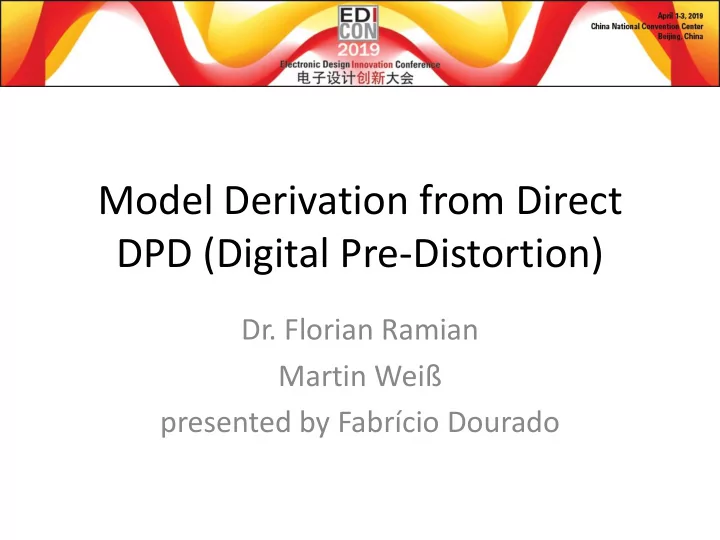

Model Derivation from Direct DPD (Digital Pre-Distortion) Dr. Florian Ramian Martin Weiß presented by Fabrício Dourado
Agenda • Introduction: DPD and Direct DPD • Model based DPD • How to convert the results of Direct DPD into a model based DPD • Summary
Introduction Efficiency: • Maximum around P out,max • Operating cost / battery lifetime • Linearity degradation: out of band emissions, higher EVM Pre-Distortion: • Modify the DUT input signal so that the output of the DUT is linear
Challenges Challenges: • Know- How required on how to “fit” the algorithms for effectiveness • DUT specific, adaption required for new devices • Find the right trade-off, cost of DPD (complexity, energy consumption) vs. PA back-off Device, application, maybe even vendor specific Questions: • What is the maximum EVM/ACLR of my PA, if I had the perfect DPD? • Is there a generally valid approach to compare different amplifier designs? • Can I convert this theoretical performance into something usable?
Direct DPD • The original waveform A is pre-distorted sample-by-sample • The amount of pre-distortion is based on the measurement M • M is compared to A, and the complex difference is used to generate the pre-distorted waveform P • No “algorithm” involved, that describes the dependency between A and P • Iterative process DUT A(nT) M(nT) P(nT)
Model Based DPD Traditional: • Reference algorithm, e.g. Polynomial, Memory-Polynomial, Volterra, etc. • Highly sophisticated derivation of coefficients (save computational effort) • Fits for one specific DUT • Can be applied to all signals (waveforms), i.e. real-time application • Inverse of DUT model DUT TX Chipset DUT ෨ A 𝑄, 𝑙 𝑞,𝑛 Inverse
Deriving a Model from Direct DPD • Least Squares Fitting of a configurable Memory Polynomial (Polynomial Order P, Memory Depth M) in Matlab • 𝐺 𝐵 𝑜𝑈 , 𝑄, 𝑁 ! = 𝑄(𝑜𝑈) • Result: Memory Polynomial describing the pre-distortion ෨ 𝑄 𝑜𝑈 • Generate calculated pre-distorted signal ෨ 𝑄 𝑜𝑈 𝑄 𝑁 𝑞−1 ෨ 𝑄 𝑜𝑈 = 𝑙 𝑞,𝑛 𝐵 𝑜𝑈 − 𝜐 𝑛 𝐵 𝑜𝑈 − 𝜐 𝑛 𝑞=1 𝑛=1
Deriving a Model from Direct DPD Requirements • Matlab license required • Any other function can be supplied in a Matlab function – Volterra – Simplified memory polynomial • Pre-distorted signals required • R&S FSW-K18D, FPS-K18D, or FSV3-K18D deliver the pre-distorted waveforms • Using K18D, Matlab, and the R&S tool, no programming knowledge is required • With recommended tools, process is fully automated
Deriving a Model from Direct DPD Signal Flow For each of the N Direct DPD Signals Iterative Direct DPD (e.g. in FSW-K18D) Calculate coefficients k Compare Measure against Pre-Distorted Reference Signal from Coefficients Pre-Distort (Direct Measure DPD) N iterations
Deriving a Model from Direct DPD Iterative Approach • Iterative approach Mem. Poly. converges (7,5) • After convergence, noise Amplifier Out (from measurement) is the Direct DPD main difference between consecutive results • Overview of all measurement results allows directly picking the best fit
Summary • Direct DPD is a convenient method to compare different PA designs • Iterative approach supported • High dynamic range measurements possible using I/Q averaging feature • Model optimization can be done w/o hardware, based on the Direct DPD results
Recommend
More recommend